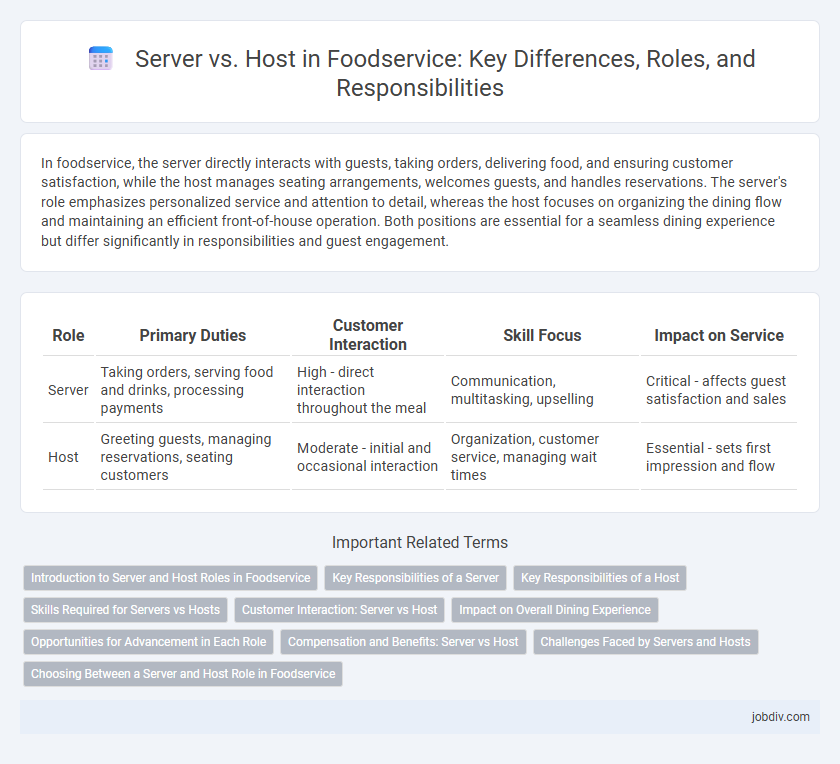In foodservice, the server directly interacts with guests, taking orders, delivering food, and ensuring customer satisfaction, while the host manages seating arrangements, welcomes guests, and handles reservations. The server's role emphasizes personalized service and attention to detail, whereas the host focuses on organizing the dining flow and maintaining an efficient front-of-house operation. Both positions are essential for a seamless dining experience but differ significantly in responsibilities and guest engagement.
Table of Comparison
| Role | Primary Duties | Customer Interaction | Skill Focus | Impact on Service |
|---|---|---|---|---|
| Server | Taking orders, serving food and drinks, processing payments | High - direct interaction throughout the meal | Communication, multitasking, upselling | Critical - affects guest satisfaction and sales |
| Host | Greeting guests, managing reservations, seating customers | Moderate - initial and occasional interaction | Organization, customer service, managing wait times | Essential - sets first impression and flow |
Introduction to Server and Host Roles in Foodservice
Servers in foodservice manage direct customer interactions, taking orders, delivering food, and ensuring guest satisfaction at the table. Hosts primarily control the front-of-house experience by greeting guests, managing reservations, and coordinating seating arrangements to optimize flow. Both roles are essential for efficient restaurant operations, balancing customer service and operational logistics.
Key Responsibilities of a Server
Servers in foodservice are primarily responsible for taking accurate customer orders, delivering meals promptly, and ensuring guest satisfaction throughout the dining experience. They manage item modifiers, communicate special requests to kitchen staff, and handle payment transactions efficiently. Servers also monitor table needs, replenish beverages, and address any customer concerns to create a seamless service flow.
Key Responsibilities of a Host
A host in foodservice primarily manages guest seating by greeting customers, organizing waitlists, and coordinating table assignments to optimize dining room flow. They ensure a welcoming atmosphere while efficiently communicating with servers and kitchen staff to maintain service timing. This role is crucial for enhancing customer satisfaction and operational efficiency in a restaurant.
Skills Required for Servers vs Hosts
Servers require strong communication skills, multitasking abilities, and a thorough knowledge of the menu to effectively take orders and ensure customer satisfaction. Hosts need exceptional interpersonal skills, patience, and organizational abilities to manage reservations, greet guests warmly, and coordinate seating efficiently. Both roles demand a friendly demeanor and teamwork, but servers focus more on order accuracy and service speed, while hosts prioritize customer flow and first impressions.
Customer Interaction: Server vs Host
Servers engage directly with customers by taking orders, offering menu recommendations, and ensuring satisfaction throughout the meal, creating a personalized dining experience. Hosts primarily manage the initial customer interaction by greeting guests, managing reservations, and seating patrons efficiently to maintain smooth restaurant flow. Both roles require strong communication skills, but servers emphasize ongoing interaction, while hosts focus on first impressions and guest logistics.
Impact on Overall Dining Experience
Servers directly influence the overall dining experience by providing personalized attention, timely order delivery, and addressing customer needs, which enhances satisfaction and encourages repeat visits. Hosts shape the initial perception by managing wait times, seating arrangements, and greeting guests, setting the tone for the meal ahead. Both roles are critical; effective coordination between servers and hosts ensures seamless service flow, minimizing delays and elevating guest comfort.
Opportunities for Advancement in Each Role
Servers often have more direct interaction with guests, providing opportunities to develop strong customer service skills that can lead to roles such as shift leader or restaurant manager. Hosts gain valuable experience in guest relations and reservation management, positioning them well for advancement into front-of-house supervisory or event coordination roles. Both positions offer pathways to specialized careers in hospitality, emphasizing leadership, communication, and operational expertise.
Compensation and Benefits: Server vs Host
Servers in foodservice typically earn higher compensation due to tipping opportunities, with average hourly wages ranging from $11 to $15 plus tips, while hosts usually receive a lower base pay around $9 to $12 per hour with limited tipping potential. Benefits for servers may include flexible scheduling and performance-based bonuses, whereas hosts often have access to standard employee benefits such as health insurance and paid time off. Employers may offer servers incentive programs to boost earnings, reflecting the direct impact servers have on guest satisfaction and sales.
Challenges Faced by Servers and Hosts
Servers in foodservice frequently face high-pressure environments requiring multitasking between taking orders, managing customer needs, and coordinating with kitchen staff, which leads to stress and burnout. Hosts, while primarily managing seating and customer flow, encounter challenges in handling peak hours, resolving wait time conflicts, and maintaining guest satisfaction without direct control over service speed. Both roles demand strong communication skills and adaptability to ensure smooth dining experiences despite operational hurdles.
Choosing Between a Server and Host Role in Foodservice
Choosing between a server and host role in foodservice depends on strengths in customer interaction and multitasking. Servers excel in order accuracy, upselling, and providing personalized dining experiences, boosting revenue through direct guest contact. Hosts manage seating flow and customer greetings, essential for efficient table turnover and creating positive first impressions that impact overall service satisfaction.
Server vs Host Infographic

 jobdiv.com
jobdiv.com